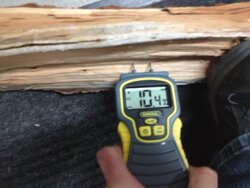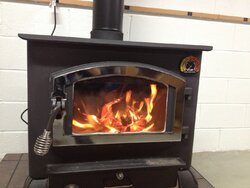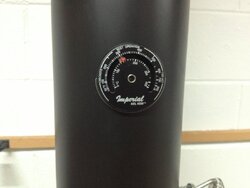Hey all, hope everyone is doing well. Last week I moved my stove from my main living floor to my basement. When the stove was on the main living floor I would get cooked out of rooms but I would almost never have any coals at the end of the burn no matter what species of wood I would use (hard woods) Last weekend I finally had the time (injury) and the help of two friends to complete the new triple wall chimney and take the stove from upstairs to the basement. I love having the stove down there, It puts out the perfect amount of heat now for upstairs (low 70's) but I'm experiencing a problem with a ton of coals at the end of my burn cycle. I'm trying to think why all of a sudden this is a problem. The question is would I have a problem with excessive draft pulling all the heat out of the box, or forcing the wood to off gas to fast? Would a key damper fix this. The stove is a modern epa US Stove model 2500 (tractor supply) My chimney height went from 16ft (up stairs) to 24ft, both new an old chimney's has the 1st 6ft of pipe as single wall, then its triple wall from the support box to the cap. Also the basement install, my walls are cinder block type with no insulation, could the non insulated wall rob heat from the stove and that's why I have tons of coals?
Moved stove - problems with coals now
- Thread starter kennyp2339
- Start date
-
Active since 1995, Hearth.com is THE place on the internet for free information and advice about wood stoves, pellet stoves and other energy saving equipment.
We strive to provide opinions, articles, discussions and history related to Hearth Products and in a more general sense, energy issues.
We promote the EFFICIENT, RESPONSIBLE, CLEAN and SAFE use of all fuels, whether renewable or fossil.
You are using an out of date browser. It may not display this or other websites correctly.
You should upgrade or use an alternative browser.
You should upgrade or use an alternative browser.
- Status
- Not open for further replies.
Are you running the air control closed more now than before?
Is this the same wood you were burning when the unit was upstairs?
Are you getting the same sort of stove top temps you were seeing when the unit was in the old location?
Is this the same wood you were burning when the unit was upstairs?
Are you getting the same sort of stove top temps you were seeing when the unit was in the old location?
To answer your questions, I have not changed any of my burning practices.. When the stove is in cruise mode the air is shut all the way, I'm using the same wood ( cherry , ash, white oak all with in 9-15%) I don't have a stove top thermometer, I have a Rutland for the chimney pipe and it pretty much stay in " good burn zone" like when the stove was up stairs, I do have more active secondary's and most of the excess large coals are in the rear of the box
fire_man
Minister of Fire
I think you are correct that the wood is outgassing faster than in your previous setup and therefore you reach the coaling stage faster. You're not really at the end of your burn cycle when you reach the coaling stage, you simply shortened your total burn time and got to the coaling stage quicker.
The more active secondaries and taller chimney suggest your draft is better which should cause the stove to burn faster and reach the coaling stage quicker. A key damper would slow it down so you keep more heat in the stove and send less out the flue.
The classic coaling problem is caused by unseasoned wood or too frequent reloads in conjunction with a low air damper setting - but that does not seem to be the case for you.
That's my 1 cent's worth!
The more active secondaries and taller chimney suggest your draft is better which should cause the stove to burn faster and reach the coaling stage quicker. A key damper would slow it down so you keep more heat in the stove and send less out the flue.
The classic coaling problem is caused by unseasoned wood or too frequent reloads in conjunction with a low air damper setting - but that does not seem to be the case for you.
That's my 1 cent's worth!
Last edited:
Fire-man... Thanks brother, I'm going to pick one up tonight, I'll post my findings
Gotta start somewhere. And it doesn't hurt to give that a go.
However, the whole situation has me scratching my head. More draft should let more air pull through the stove, and while it may improve / over-improve secondaries, I just can't wrap my mind around it suddenly making a coaling issue.
In general, the only way I can see a key damper here working is if by using it, it allows you to open the primary air just a touch, which would let more air come in through the airwash, and help burn the coals down.
In saying your wood is 9-15%, that surprises me. The only wood that I have even gotten down less than 15 or so is the stuff that my house is built out of. Are you checking the moisture on a freshly split face of the wood?
If so, try picking through the wood and doing just a load of cherry and ash and see if that makes a difference. If you've gotten into more oak, that often takes longer to season and might be an issue.
Keep in mind, the damper isn't really keeping heat in the stove, it is just restricting the draft.
fire_man
Minister of Fire
Pen
I hear you on "the damper isn't really keeping heat in the stove, it is just restricting the draft."
But when I'm firing up after a reload, it takes longer to heat up (based on stovetop temps) if the inlet air damper is wide open rather than throttled back some. It seems to stand to reason that too fast a draft would send more btu's out the flue rather than warming the stove and room. But I see the contradiction.
I hear you on "the damper isn't really keeping heat in the stove, it is just restricting the draft."
But when I'm firing up after a reload, it takes longer to heat up (based on stovetop temps) if the inlet air damper is wide open rather than throttled back some. It seems to stand to reason that too fast a draft would send more btu's out the flue rather than warming the stove and room. But I see the contradiction.
There's also a difference in what they key damper will do to the stoves operation, as compared to what we normally see the air control do.
I'm just confused in that he didn't mention reaching the coaling stage quicker, but rather that he simply wound up with an excessive amount of coals.
Anxious to see how he makes out.
I'm just confused in that he didn't mention reaching the coaling stage quicker, but rather that he simply wound up with an excessive amount of coals.
Anxious to see how he makes out.
I'm really aware just now, due to my own recent experiences, how much a person can get thrown by different burn conditions. It takes a while to feel into new stove/set up behaviour.
If it was me I'd be tempted to not add another factor - such as a damper - into the equation right away.... At least not until you've just let things be for a while and perhaps tried to see what happens if you just give the coals a chance to burn down a bit longer before reloading. Maybe the coals phase of your burn cycle Is just longer now that your stove has a new location. Could it be that simple?
If it was me I'd be tempted to not add another factor - such as a damper - into the equation right away.... At least not until you've just let things be for a while and perhaps tried to see what happens if you just give the coals a chance to burn down a bit longer before reloading. Maybe the coals phase of your burn cycle Is just longer now that your stove has a new location. Could it be that simple?
If the wood is still very well seasoned then most likely this is due to lower draft slowing down the burn. Basements typically are low or negative pressure zones. Try opening a nearby window a crack and see if this makes any difference in the coaling.
kennyp, were both chimneys straight up through the house or through the wall and then up?
kennyp, were both chimneys straight up through the house or through the wall and then up?
Both chimneys were straight up and down through the house.. My house is a raised ranch ... So the basement is almost to grade with the ground.. Since on a hill the back part of the foundation were the stove is is approx 5ft below grade, but I have a walk out garage with level ground. I don't think I have a negative pressure situation, I think I have an over draft issue.. I picked up the damper and a length of stove pipe, I'll put it together and report on the findings... Thanks to everyone that made comments.. I love how everyone bounces ideas off each other, valuable info
You are front line and seeing what is happening, so we'll have to trust your observations. FWIW in our stove lots of coals is due to low draft or damp wood, sometime both. High draft often moves a lot more air over the coal bed and burn it down quicker.
fire_man
Minister of Fire
Threw a couple pieces in, I have full secondary's going and flipped the damper shut, maintaining my stack temp as in the first pic.. I closed the damper fully about 5 min ago, I'm noticing some good results so far, my fire seems to be calmer with lazier flames, girlfriend even said wow, looks like an upstairs fire View attachment 145003hardly any smoke coming out the chimney cap
Just a quick comparison. The 1st pic is yesterday's fire air fully closed on the stove box, no damper and here's today's fire air fully closed with a damper added to the first length of pipe coming out of the stove 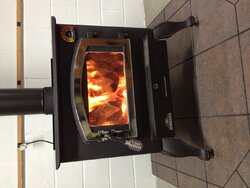
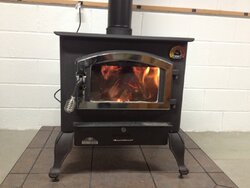 the velocity of the fire seems much slower than yesterday's... I will report tomorrow about the coal situation and let you all know if it improved or not
the velocity of the fire seems much slower than yesterday's... I will report tomorrow about the coal situation and let you all know if it improved or not

 the velocity of the fire seems much slower than yesterday's... I will report tomorrow about the coal situation and let you all know if it improved or not
the velocity of the fire seems much slower than yesterday's... I will report tomorrow about the coal situation and let you all know if it improved or notChuck the Canuck
Feeling the Heat
Thank you, but I'm actually getting rid of it, hopefully the blaze king princess that I ordered comes in soon, it's about 3 weeks later and the dealer said approx 2nd week in December before the shipment comes in.. This stove looks good and is a pretty good heater but its falling apart , I have cracks around the edges of the door, I had to retap all screw holes for the secondary reburn tubes because they sheared off when I removed the tubes to drop the flakey baffle board down to clean the chimney, other then the good heat this stove is a poor performer and I do not recommend this stove or brand to anyone, save your money and buy a better quality stove, and if your on a budget go with englander , they use beefier steel and its made in America
Chuck the Canuck
Feeling the Heat
I do not recommend this stove or brand to anyone, save your money and buy a better quality stove, and if your on a budget go with englander
I've already got a champion of a stove running right downstairs in me basement!

Cheers,
At 20:45 I loaded the stove up, it was running at full capacity, good heat, dampered down and closed the air down, went to bed.. Woke up this morning at 5:00, went down stairs and was happy on what I saw, fewer coals, more ash then previous fires, my fire box conditions were that of having the stove burn through like it was upstairs, the key damper is a success. To all that are reading this please note that perhaps this is an isolated problem and I agree with Begreen that most basement installs with draft issues occur due to weaker draft, not over draft like my issue, once again thank you everyone for sharing comments, and having a great discussion..Be safe
fire_man
Minister of Fire
Thank you.. I just got home from work.. Gone for 10 hrs.. Did a reload, the amount of ash to coal is much improved, it's just like pre basement install... I'm so happy to have this figured out in a quick amount of time, also the heat output of the stove has really improved, now I don't think I need to drop big $$ I don't have right now and can hold off till later in the winter when I get my tax return to stud and insulate the cinder block walls, I can get by at the moment, but I know insulation is the way to go to do it right
Thank you.. I just got home from work.. Gone for 10 hrs.. Did a reload, the amount of ash to coal is much improved, it's just like pre basement install... I'm so happy to have this figured out in a quick amount of time, also the heat output of the stove has really improved, now I don't think I need to drop big $$ I don't have right now and can hold off till later in the winter when I get my tax return to stud and insulate the cinder block walls, I can get by at the moment, but I know insulation is the way to go to do it right
By closing the pipe damper down, did you change anything else? Did you leave the primary air open any more? If not, I'm very happy to hear of the results, but still surprised at the outcome.
Just trying to get a better grip on the whole circumstance for future reference in helping other folks.
Again, very glad to hear you have things improving! Just trying to wrap my mind around what's going on here, as it's a case that is strange!
pen
I still and always have shut my air control all the way down on my stove, the damper that was added to the chimney pipe created enough resistance to slow the natural draft while the stove was running.. Without the damper in the smoke pipe and with my stove air shut down there was still a considerable amount of draw, my thinking is because on modern stoves the design of the air control will not allow a full air shut down, plus the secondary air system has Fixed noncontrollable air inlets unless you tape them or seal them off manually
I still and always have shut my air control all the way down on my stove, the damper that was added to the chimney pipe created enough resistance to slow the natural draft while the stove was running.. Without the damper in the smoke pipe and with my stove air shut down there was still a considerable amount of draw, my thinking is because on modern stoves the design of the air control will not allow a full air shut down, plus the secondary air system has Fixed noncontrollable air inlets unless you tape them or seal them off manually
Exactly, that's what makes this so confusing to me.
With most situations, restricting the chimney while keeping the primary fully closed means all air is restricted, and everything in the firebox, especially coals at the later stage when things in the chimney cool off the draft gets less, will get less air.
That said, with the primary air fully shut, the secondary air system gets the greatest advantage of pull from the draft, putting air at the top of the firebox.
This all would make sense to me if you were able to leave the air open a bit and get these results, as leaving the air open a bit would shift the balance from the secondaries back to air that can get a better shot at the coals....
Regardless, I'm not dismissing what you have found, and am very happy things are good as that's what's supposed to happen here! Just wish I could make better sense of the results, but..... even if I can't explain it, good results are good results! Therefore, well done!
Another one for the books.
- Status
- Not open for further replies.
Similar threads
- Replies
- 5
- Views
- 421
- Replies
- 16
- Views
- 812
- Replies
- 19
- Views
- 616
- Replies
- 48
- Views
- 2K


